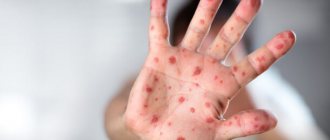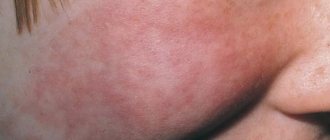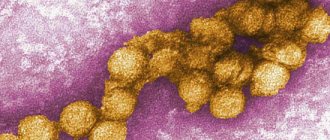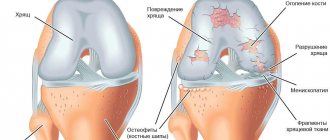Measles is an acute viral infection, which is characterized by fever, the development of catarrhal symptoms and the appearance of a specific rash. Measles is highly contagious. Transmitted from person to person by airborne droplets. The disease develops approximately 10 days after exposure.
Manifestations of the disease begin with fever, runny nose, and cough. Conjunctivitis and photophobia develop. From about 4 days of illness, a characteristic rash appears on the mucous membranes of the oral cavity and on the skin. The skin rash appears in stages starting from the head. Then moves on to the torso, arms and legs. By day 4, the rash begins to darken and peel. Then it disappears in the same sequence in which it appeared. There is no specific treatment for measles. Complications of infection occur in about a quarter of cases. These include: bronchitis, sinusitis, pneumonia and encephalitis.
Measles is a highly contagious infection; upon contact with a sick person, 9 out of 10 unvaccinated children become infected. The measles virus tends to infect the cells of the child’s immune system. This entails a high risk of infectious complications. In the pre-vaccination era, measles was one of the leading causes of child mortality. In addition, measles is often complicated by a disease of the nervous system. Measles encephalitis develops in approximately one in 300 affected children and has no specific treatment. Due to the high “infectiousness”, outbreaks of measles still occur in the world, especially in communities with low vaccination coverage.
Rubella is a viral infection characterized by mild catarrhal symptoms and the appearance of a rash. Rubella has a long incubation period. It takes 2-4 weeks from infection to the development of the disease. In this case, a person becomes infectious already in the middle of the incubation period and remains infectious after the rubella rash disappears. The first symptoms of the disease are nonspecific - a slight increase in temperature, a slight runny nose, weakness, and enlarged lymph nodes. After about 2 days of illness, a characteristic pinpoint bright rash appears. First on the head, then gradually descends to the limbs. After a few days, the rash goes away on its own without leaving a trace. Rubella in children is usually not severe. Rarely leads to complications.
Rubella has a mild course in children. However, due to the fact that the patient is contagious for a long time, even without a clinic, rubella spreads easily. Rubella infection is extremely dangerous for pregnant women, especially in the first trimester of pregnancy. In about a quarter of cases, women who have had rubella give birth to babies with one or another severe pathology. The most common of them is congenital cataracts (visual impairment, including blindness).
Mumps (mumps) is an acute infectious disease characterized by damage to the endocrine glands (usually the parotid salivary gland). The virus is transmitted by airborne droplets, less often by contact (from contaminated surfaces). The disease has a long incubation period - approximately 16-18 days. However, from the middle of the incubation period, the child can be contagious. The disease begins with a slight increase in temperature, general weakness, and dry cough. On days 2-3, the parotid salivary glands enlarge. After about a week, the size of the glands begins to decrease and the patient recovers. In some cases, recovery does not occur, complications appear - damage to the pancreas, mammary or gonads, nervous system, hearing impairment. It is important to note that mumps has no specific treatment.
Online consultation with pediatrician Olga Nikolaevna Tekutyeva
Registration online
During the consultation, you will be able to voice your problem, the doctor will clarify the situation, interpret the tests, answer your questions and give the necessary recommendations.
Mumps is often not severe and rarely causes complications. But these complications persist for life. These include infertility, deafness or the development of diabetes. In addition, those who have had mumps do not always develop immunity. The disease may recur in adulthood. The risk of complications in adults increases significantly.
Why are measles, rubella and mumps dangerous?
The main problem of these infections is the possibility of intrauterine infection of the fetus during the mother’s illness, when the consequences can be very serious both for the health of the baby and for the life of the unborn child. Severe symptoms in the sick person also cause a lot of inconvenience and trouble. It is worth considering in more detail how each of these infections manifests itself and what the threat is.
Previously, almost all children suffered from measles. The fact is that this disease is very contagious; if contact occurs with a patient, measles is transmitted in 95% of cases. In particularly severe cases of the disease, complications in the form of hepatitis, pneumonia and encephalitis are possible; rarely, measles can even lead to death. For pregnant women, the danger of getting measles is that in the early stages of pregnancy the disease increases the likelihood of developing dementia or mental retardation. The respiratory system suffers, which can lead to inflammation and death of the fetus. In late pregnancy, the disease can trigger early labor, and the baby becomes infected from the mother through the birth canal. As a result, characteristic rashes appear on the skin and mucous membranes. Since the child’s immunity is still weakened, complications in the form of encephalitis and pneumonia may develop against this background.
Regarding mumps, it should be noted that the infection can affect the membranes of the brain and spinal cord in approximately 15% of cases of development of the disease, one person in 20,000 people with mumps may experience deafness, in men and boys, mumps most often causes inflammation of the testicle and its appendages, in adult men – prostatitis. Doctors call pancreatitis, nephritis, oophoritis, mastitis and arthritis as rare but possible complications of mumps.
The main manifestations of rubella are a small rash, inflammation of the lymph nodes, and fever. But this is just the tip of the iceberg regarding the complexity of this disease. If a woman contracts rubella in the first trimester of pregnancy, there is an 80% chance that her child will have heart defects, mental retardation, deafness or cataracts at birth. But carrying the pregnancy to term will also be a problem for her - very often rubella can cause intrauterine fetal death or stillbirth.
In adulthood, the course of the disease can be very severe, with a large number of complications arising. But even in childhood it is better not to get sick with these infections. Immunity from the mother (innate immunity) is unstable and lasts only a few weeks after birth.
Why vaccinate your child against mumps?
Mumps (mumps) is not a deadly disease, but can lead to extremely unfavorable complications. It gained fame due to the fact that it is a fairly common cause of infertility in men, which develops as a result of orchitis - inflammation of the testicles. The fact is that the mumps virus affects glandular tissue and is not limited to the postauricular salivary glands (although they are, indeed, usually affected first), but can develop in the tissues of the thyroid gland, pancreas, testicles in boys or ovaries in girls.
Two of the most common myths about the vaccine against it are associated with this feature of mumps. First: the vaccine causes infertility in boys. Of course, this is not true. When grafting, testicular tissue is not affected. Second: there is no point in vaccinating boys before puberty. And this is not so - infertility is caused not by low-quality sperm, but by atrophy of testicular tissue, which, unfortunately, does not depend on age. And high-quality immunity is formed after revaccination, and you may simply not have time to vaccinate your child before he gets sick.
The second question, no less frequent: if mumps is dangerous only for boys, why vaccinate girls? Just for the sake of the notorious population immunity? Of course not. The fact is that, in addition to orchitis, partotitis can cause pancreatitis, and this is lifelong, because the pancreas tissue is not restored; as well as encephalitis and meningoencephalitis - the most dangerous types of brain inflammation. Not very often, but it still happens that the experience of mumps ends in deafness.
Measles-rubella-mumps vaccination
Young children should be vaccinated exactly at one year of age and again at the age of six. Revaccination of children at 6 years of age is necessary for the reason that not every body develops stable immunity from one vaccination.
In the future, revaccination is carried out at the age of 15-17 years in order to prevent serious health consequences:
- It is extremely necessary to extend protection against rubella for women planning pregnancy before pregnancy, since this disease is the most dangerous for this process.
- Immunity against measles acquired in childhood must be reactivated by receiving a new dose of the vaccine.
- It is important to prolong protection against mumps for men, since it is during adolescence that all the negative consequences for male reproductive function can occur when suffering from this infection.
In childhood, multicomponent vaccination is tolerated quite easily, the body rarely reacts to vaccination with severe conditions, and protection is fully formed. If a child was not vaccinated in early childhood, then he must receive the first vaccine at 13 years of age.
In modern medicine, there is a clear prescription for vaccination of adults with the above vaccine. For example, for those people who were born before 1957, vaccination is not indicated due to the fact that in all the years before, epidemics of this disease broke out everywhere, and people with a 90% probability have already suffered from the disease. All those who were born after 1957 and have not been vaccinated are recommended to receive two doses of a live vaccine, administered at intervals of 1 calendar month. This prescription is intended for adolescents, but 1 dose of vaccine is recommended for older adults.
For young women, the main goal should be mandatory vaccination against rubella, since this is the disease that has a very bad effect on the child if you get it during pregnancy. Rubella in the first 90 days of pregnancy often causes miscarriages and stillbirths. Other negative consequences include the birth of a child with congenital rubella syndrome, which is accompanied by the presence of developmental anomalies such as heart disease, cataracts and deafness. This syndrome may be accompanied by mental retardation, liver damage, kidney damage and other serious diseases.
An important point is the fact that the course of rubella can be in a latent form. In this case, the woman feels great, not paying attention to the minor rash, which goes away on its own after a few days. Meanwhile, the virus penetrates the placenta into the fetus, affecting all vital organs and systems. If a pregnant woman is suspected of having latent rubella, doctors carry out several stages of laboratory testing, the results of which should demonstrate the production of antibodies to this disease. If this occurs in the early stages, it is recommended to terminate the pregnancy to avoid the birth of a child with multiple deformities.
That is why, before planning a pregnancy, women who have not been ill should definitely take care of the appropriate vaccination, which protects against the disease 100% for the next 15 years. After vaccination, it is necessary to protect against pregnancy for another month.
Pregnant women are not specifically vaccinated, but sometimes vaccination occurs already during pregnancy. At the same time, the risk of intrauterine damage to the fetus is very low. As a rule, no changes in fetal development occur when vaccinated against rubella, which has been confirmed by numerous studies.
Rubella vaccination and pregnancy.
It has been proven that antibodies after rubella vaccination last for approximately 10 - 20 years.
- If a woman planning a pregnancy is sure that she was vaccinated no more than 10 years ago, and has received at least 2 vaccinations throughout her life, she can safely plan a pregnancy.
- The second option is if the woman has not been vaccinated, the vaccination schedule has not been completed, or she does not know which vaccinations were given and when. Before planning a pregnancy, it is better to get vaccinated against rubella.
- If a woman has been vaccinated twice, but more than 10 years have passed since vaccination. In this case, before planning a pregnancy, you can take a blood test for antibodies. If the antibody level is sufficient, you can plan a pregnancy. If the level of antibodies decreases or is absent, the woman is recommended to get vaccinated.
How to prepare for the measles-rubella-mumps vaccine
In order for successful vaccination without consequences and side effects, it is necessary to prepare for vaccination. The morning before vaccination, the child’s temperature is measured and his general well-being is determined. During a visit to the hospital, the person being vaccinated must be examined by a doctor, but before this, the child should not spend a long time in the same room with sick people, waiting for his turn. It is better if one parent sits in line, while the other takes a walk with the baby on the street. This way you can avoid infection with all kinds of viruses that do not have time to manifest themselves before vaccination. You may need to undergo some tests before vaccination if you have any suspicions about your child's health. On the eve of vaccination, it is not advisable to visit places with large crowds of people, especially when epidemics of viral infections are raging around.
Also, in preparation for vaccination, children with allergic manifestations are prescribed desensitizing drugs several days before vaccination. For children susceptible to colds, doctors recommend restorative medications 2 days before and 12 days after the planned vaccination.
For diseases of the nervous system, it is necessary to prepare especially carefully for vaccinations. For chronic diseases, on the eve of vaccination, it is necessary to consult a neurologist who can prescribe anticonvulsants. All children with chronic diseases can be vaccinated only during stable remission. If you are constantly taking special medications that support the body during chronic diseases, vaccination can be done along with such treatment.
Vaccination calendar
Modern vaccines against the infectious diseases in question are complex, allowing the body to immediately form immunity against the viruses of these diseases. However, there are mono-vaccines that are also sometimes used. The vaccination schedule provides for the first administration of a complex vaccine at the age of 1 year. Next, revaccination is carried out at 6 years, then from 15 to 17 years, from 22 to 29 years, and subsequently every 10 years.
In the absence of vaccination in early childhood, the first vaccination is usually given at the age of 13, and then from 22 to 29, and so on.
If the vaccination schedule was accidentally violated for objective reasons, you should:
- Get vaccinated as close as possible to the required schedule, observing a time interval between revaccinations of at least 4 years.
- If emergency prevention is necessary, after contact with a patient, you can vaccinate with the appropriate monovaccine. The three-component vaccine can be revaccinated 1 year after the introduction of such vaccines.
It is important to understand that numerous reviews about the dangers of vaccinations for the nervous system have led to a sharp increase in the percentage of unvaccinated children in some regions. However, according to medical data, the danger of the above diseases significantly exceeds the extremely rare complications from immunization. For example, in underdeveloped countries in Africa, about 745 thousand unvaccinated children still die from measles every year.
Measles vaccine and autism
In 1998, a British scientist published an article in a scientific journal that the preservative merthiolate contained in the measles vaccine causes inflammatory bowel disease and autism in children. A little later, other researchers refuted the article and established that the facts in it were manipulated. And the author himself admitted that he published his research for commercial purposes. He wanted to support sales of the vaccine without merthiolate. The article was refuted, the scientist was deprived of all regalia and the title of doctor.
The publication managed to generate so many rumors that even now at receptions I often hear speculation about a connection between vaccinations and autism. Since then, a large amount of research has been carried out. The last, long-term one, involving 400 thousand vaccinated children, ended in 2020.
None of the studies have confirmed the link between vaccination and autism. Unfortunately, the causes of this disease have not yet been established.
Vaccine injection site
The complex vaccine is administered in two ways - subcutaneously or intramuscularly. Children under three years of age are most often vaccinated in the outer thigh, and subsequently in the deltoid brachialis muscle.
The choice of such places for vaccination is explained by the fact that here the skin is very thin, there is little subcutaneous fat and the muscles are very close. When the vaccine gets into the fatty layer, it is deposited, enters the blood slowly and subsequently does not have the desired effect.
The buttocks are also not suitable for vaccine administration due to the inaccessibility of the gluteal muscles for the vaccination needle, due to the developed subcutaneous fat in these areas.
What should I do if I have a moderate or severe reaction?
What should you pay attention to?
- For any unusual condition, such as a high temperature or changes in behavior. Signs of a serious allergic reaction may include difficulty breathing, hoarseness or wheezing, hives, paleness, weakness, fast heartbeat, or dizziness.
What needs to be done?
- Call the doctor or take the patient to the doctor immediately.
- Tell your doctor what happened and the date and time the reaction occurred and the date and time you received the vaccine.
Contraindications to vaccination against measles, rubella, mumps
Among all contraindications to vaccination against measles, mumps and rubella, there are 2 main groups - temporary and permanent.
Temporary specialists include:
- the presence of any diseases in the acute period;
- pregnancy period;
- use of gamma globulin and other blood products;
- vaccination or testing for antibodies to tuberculosis.
All these factors do not eliminate the need for vaccination, but require a short time period (on average 2 to 6 weeks) until the body’s condition stabilizes.
Among the constant and absolute contraindications, in which measles-rubella-mumps vaccination is impossible in principle, are:
- allergy to gentamicin, neomycin;
- allergy to egg whites;
- Quincke's edema;
- neoplasms of various types;
- the occurrence of complications due to previous vaccination;
- blood diseases accompanied by thrombocytopenia;
- HIV infection;
- various damage to the immune system (for example, the period after transplantation of any organs).
Preparations for vaccination
In our country, imported (Priorix, MMR-II) and domestic trivaccines are used. They contain laboratory-cultivated, live and weakened viruses from three infections. According to indications, a divaccine (against two infections) or vaccinations against only one disease can be administered. Drugs can be imported or domestic.
Sources:
- https://www.ncbi.nlm.nih.gov/pmc/articles/PMC6605874/ Hervé Haas, Patrick Richard, Cécile Eymin, Anne Fiquet, Barbara Kuter and Benoit Soubeyrand. Immunogenicity and safety of intramuscular versus subcutaneous administration of a combined measles, mumps, rubella, and varicella vaccine to children 12 to 18 months of age // Hum Vaccin Immunother. 2019; 15(4): 778–785.
- I.L. Solovyova, E.A. Alexandrova, E.M. Lezhen, O.V. Anosova, A.A. Solovyova. Vaccinal prevention of measles and mumps in children in modern conditions // Ulyanovsk Journal of Medical Biology, 2013, No. 4, pp. 47-53.
- N.V. Yuminova, E.O. Kontarova, N.V. Balaev, S.V. Artyushenko, N.A. Kontarov, N.V. Rossoshanskaya, E.S. Sidorenko, R.R. Gafarov, V.V. Zverev. Vaccinal prevention of measles, mumps and rubella: objectives, problems and realities // Epidemiology and Vaccinal Prevention, 2011, No. 4(59), pp. 40-44.
What not to do after vaccination
After immunization, the following rules must be observed:
- The first half hour after vaccination must be under the supervision of a doctor.
- Taking water procedures after vaccination is not prohibited, but it is not advisable to wet or rub the injection site for a long time, in order to avoid a local reaction.
- Introduce new, especially exotic, foods into the diet, the body’s reaction to which has not yet been studied.
- For a couple of days after vaccination, you should not be in crowded places so as not to become infected with a common ARVI and not confuse it with a reaction to the vaccine.
On the eve of vaccination, you should consult with your doctor about what medications you should have at home as an emergency and for the first symptoms of a reaction to the vaccine.
Reactions and complications to the measles-rubella-mumps vaccine
The measles component of a multicomponent vaccine has the greatest reactogenicity, that is, it causes specific conditions in the body. Among the most common reactions, doctors identify local redness or swelling at the injection site, which should subside over the next few days, coughing 6-11 days after vaccination, decreased appetite, nosebleeds, increased body temperature ranging from 37.2 to 39 degrees, rashes starting from the scalp and gradually moving to the torso.
The main complications of the measles component of a multicomponent vaccination include reactions that may appear 6-11 days after vaccination. Among them, the most common toxic reaction occurs when the child has a fever, his body temperature rises, the lymph nodes are inflamed, his throat is sore, weakness is pronounced and there is a rash on the body. Such symptoms go away no later than 5 days after their onset. Less commonly, convulsions occur as a complication, and post-vaccination encephalitis may develop. There are also allergic reactions in different forms - from mild to severe (Quincke's edema).
The mumps component of the vaccine is usually easily tolerated by children. Reactions to this component occur on day 8 and can progress until days 14-16. Within 3 days, the parotid salivary glands may become slightly enlarged, the throat may become red, a runny nose may occur, and the temperature may rise slightly.
Complications from mumps vaccination are extremely rare and are much more easily tolerated than the measles component. Toxic reactions are accompanied by a rise in temperature and a general deterioration in health. Allergic reactions occur only in those who are susceptible to allergic reactions. Damages to the nervous system with the mumps component are rare and are expressed in the occurrence of meningitis.
Children's reactions to the rubella component in the vaccine are usually quite weak and rare. They can be expressed in redness of the injection site, enlarged lymph nodes, a slight increase in body temperature, the occurrence of arthralgia, and joint pain.
Doctors call the appearance of a small reddish or purple rash as a complication of the rubella component in such a vaccine.
Etiology of diseases
All three infections are viral in nature and affect the respiratory system and immune system. In severe cases and complications, internal organs, vision, the reproductive system (with mumps) and the nervous system can be damaged.
- Measles is characterized by a combination of eye and respiratory tract lesions and skin rashes. First manifestations:
- small white spots on the cheeks and gums (Koplik's sign);
- redness of the eyes;
- snot, nasal congestion;
- dry strong cough;
- heat;
- a pinpoint red rash that appears from the top of the head to the heels. Source: I.L. Solovyova, E.A. Alexandrova, E.M. Lezhen, O.V. Anosova, A.A. Solovyeva Vaccinal prevention of measles and mumps in children in modern conditions // Ulyanovsk Journal of Medical Biology, 2013, No. 4, pp. 47-53
Without treatment, measles is dangerous for the development of purulent otitis, bronchitis and pneumonia, as well as the formation of encephalitis.
- Mumps is a lesion of glandular tissue and respiratory organs. Typical for him are:
- runny nose;
- temperature increase;
- severe malaise with headache;
- muscle aches;
- pain in the masticatory muscles when swallowing;
- inflammation of the salivary glands with swelling behind the ears and along the edge of the lower jaw;
- dry mouth, decreased appetite, severe thirst.
With complications of mumps, inflammation of the appendages (in girls) and testicles (in boys) may develop, followed by infertility, as well as deafness, and the development of meningitis.
- Rubella is milder and is characterized :
- moderate temperature;
- redness of the eyes;
- the appearance of a rash on the skin;
- enlarged lymph nodes in the back of the head and neck;
- joint damage.
Rubella is especially dangerous for children and can lead to bronchitis and otitis media. For pregnant women, there is a risk of fetal defects. In rare cases, children may have bronchitis, otitis media or pneumonia.
Possible reactions
If your body reacts to the measles, rubella and mumps vaccine, you should not worry, since this is an indicator of the activity of the human body's immune system. Such reactions do not require special treatment. It is important to remember that all reactions to this vaccine occur between 5 and 15 days after vaccination. All symptoms that occur at other times are not associated with vaccination and require additional diagnosis and appropriate treatment.
The most common reactions to a multicomponent vaccine are fever, minor rash, joint pain, runny nose and cough, pain at the injection site, which disappears on its own in a short time, without the use of additional therapy.
Fever
This is the most common post-vaccination symptom possible. The temperature generally rises to subfebrile levels, and in isolated cases can reach 39-39.5 degrees. In childhood, febrile convulsions may occur due to high fever. High temperature is absolutely not necessary for the immune system to work, so it should be reduced. Antipyretic drugs based on paracetamol and ibuprofen are recommended for children at home. The form of antipyretics can be any - from suppositories, syrups in children to syrups and tablets in adults.
Rash
Rashes can occur on any area of the skin. Common places where the rash is localized are the face, the area behind the ears, neck, arms, buttocks, and back. The rash resulting from a reaction to this vaccine is very small, all shades of pink, including one that is barely distinguishable from skin color. This rash should not be smeared or treated; it goes away on its own without any consequences. It is important to remember that the presence of a rash after vaccination does not indicate that the vaccinated person is contagious.
Joint pain
Joint pain most often occurs after vaccination at a later age. In 25% of vaccinated people over the age of 25, this symptom is present and is called reactive arthritis. Joint pain can last from a day to 3 weeks. They do not require emergency treatment.
Runny nose
Mild rhinitis may occur after vaccination on the 3rd day. It lasts from 1 to 14 days and causes virtually no inconvenience to the child. This type of runny nose does not require special treatment.
Cough
In the first couple of days, a slight cough may also occur, accompanied by a sore throat. This symptom disappears on its own without special treatment.
Enlarged lymph nodes
Since the mumps vaccine is live, it can cause lymphadenitis of the parotid lymph nodes. This symptom may last for about 2 weeks.
Vaccination schedule
NKPP provides for the first administration of a complex vaccine to a patient at the age of 1 year. Revaccination is carried out at 6 years of age, from 15 to 17 years of age, and from 22 to 29 years of age. Further, every 10 years after the last vaccination. In the absence of vaccination at an early age, the first vaccination must be given at the age of 13 years. Revaccination must be completed between the ages of 22 and 29, etc.
In case of violation of the vaccination schedule (depending on the situation), it is necessary:
- vaccinate as close as possible to the NKPP - the time interval between revaccinations should be at least 4 years;
- be vaccinated with a monovaccine - provided that the child has already had any of the listed infections and does not need to create specific immunity in relation to it;
- undergoing immunization immediately after normalization of health is important for teenage girls.
Remember: children, unlike adults, tolerate the administration of a polyvalent vaccine easily. They (provided there are no contraindications to vaccination) do not experience complications or serious health consequences. If we compare the danger of the above diseases with the risks of vaccination, the former is many times greater than the unlikely harm from immunization. For example, in underdeveloped countries in Africa, about 745,000 children who have not been vaccinated with MMR still die annually from measles.
As for the adult population, in modern medicine there is a clear prescription for its vaccination. So, in particular, MMR vaccination is not recommended for people born before 1957. Earlier than this period of time, epidemics of measles, rubella and mumps broke out frequently, so with a 90% probability they had already suffered from these diseases. All those born after 1957 and who have not been vaccinated before are recommended to receive two doses of a live vaccine with an interval of 1 month (for teenagers!) For older people - one dose of an immunobiological drug.
How to prepare for MMR vaccination?
On the day of vaccination, it is necessary to measure the child’s body temperature and make sure that he is not sick. An examination by a pediatrician is required to rule out any contraindications for vaccination against measles, rubella and mumps. To prevent the risk of infection in a young patient in hospital, the time spent in a medical facility should be reduced as much as possible. It is optimal if one parent watches the queue, and the second goes outside with the child for a walk.
In preparation for vaccination, patients prone to allergies are recommended to take a three-day course of desensitizing medications. For children susceptible to colds, doctors recommend restorative medications. They should be taken 2 days before and 12 days after vaccination. Patients with a history of diseases of the nervous system need to prepare especially carefully for immunization. In particular, they are recommended to visit a neurologist and undergo a course of treatment with anticonvulsants. Such children are allowed to be vaccinated only during stable remission (with parallel administration of specialized medications, if necessary).
Contraindications to vaccination
All restrictions on vaccination against measles, rubella, mumps are divided into temporary and permanent.
Temporary ones include:
- pregnancy period;
- chronic diseases in the acute stage;
- the use of gamma globulin and other similar drugs;
- vaccination/testing for antibodies to Mycobacterium tuberculosis.
All of them require the patient to stabilize his health condition. On average it takes from 2 to 6 weeks. The exception is carrying a child. Permanent (absolute) contraindications imply a lifelong medical disqualification from the placement of CCP. They include in their list:
- Quincke's edema;
- allergy to gentamicin, neomycin, other components of the vaccine;
- egg white intolerance;
- blood diseases accompanied by thrombocytopenia;
- immunodeficiency states;
- malignant/benign neoplasms;
- complications caused by the initial administration of an immunobiological drug.
The question of how to protect the patient from the above infectious diseases in this case is decided individually. It involves a detailed study of the patient’s chart, as well as prescribing tests and additional examination.
Vaccine injection site
The complex MMR vaccine is administered in two ways - subcutaneously or intramuscularly. For children under 3 years of age, the vaccine is placed on the outer surface of the thigh. For older patients - into the deltoid muscle of the shoulder. The choice of such sites for the administration of an immunobiological drug is explained by the close proximity of the muscles and the small volume of subcutaneous fat.
For reference: when the vaccine gets into the fat layer, it is deposited, enters the blood slowly and does not have the desired effect on the body of the person being vaccinated.
Frequency of revaccination
There are no exact data regarding the duration of human protection from measles, rubella, mumps after vaccination. After a single vaccination, the patient’s immunity to these diseases can remain for 10–25 years (depending on the individual characteristics of the body). Afterwards revaccination is required. Involving repeated administration of an immunobiological drug, it is first performed at the age of 6 years. A patient develops a sufficient antibody titer when vaccinated twice.
What to do after vaccination?
You must be on the premises of the medical facility for 30 minutes after vaccination. If a newly vaccinated patient experiences an acute reaction, doctors will be able to stop it in a timely manner and prevent complications. For several days after installing the PDA, you should not visit crowded places. There is a possibility of contracting an acute respiratory viral infection and confusing it with a reaction to the administration of an immunobiological drug. There are no restrictions in terms of daily routine or hygiene procedures. The vaccinated person can shower or bathe freely. The only thing is that it is not advisable to wet or rub the injection site for a long time. No diet required. The main thing is not to introduce new foods into the diet, the body’s reaction to which has not yet been studied.
Possible reactions
If local, general reactions of the body occur to the administration of the combined MMR vaccine, there is no need to worry. They are natural (occur between 5 and 15 days after vaccination) and disappear on their own a few days after manifestation. All symptoms that occur at other times are not associated with the prevention of measles, rubella and mumps. They require specialist consultation, diagnosis and appropriate treatment.
The measles component of the polyvalent vaccine has the greatest reactogenicity.
Among the reactions it causes in patients are:
- local redness, swelling at the injection site;
- rash in the face, neck, back, arms, buttocks;
- cough (occurs 6–11 days after vaccination);
- increase in body temperature within 37.2 – 39°C;
- decreased/partial loss of appetite.
To bring down a high temperature during this period of time, the patient is recommended to take an antipyretic. The form of the latter can be different - from suppositories and syrups in children to tablets in adults. The mumps component of the vaccine is much easier to tolerate. Reactions to its introduction into the body appear on the 8th day after vaccination and can persist for a week after occurrence. Among them are lymphadenitis of the parotid glands, redness of the throat, and runny nose. The possibility of an increase in body temperature to subfebrile values (from 37.1 to 38.0 ° C) is allowed. Reactions to the rubella component are rare and mild. They can be expressed in hypermia of the area of administration of the immunobiological drug, enlargement of the posterior cervical and occipital lymph nodes, and the occurrence of joint pain (reactive arthritis). Such symptoms do not require special therapy. But if they cause severe discomfort, you can consult a doctor, and he will prescribe medications that can mitigate their symptoms.
Complications of MMR vaccination
Post-vaccination complications following the administration of the measles, rubella and mumps vaccine are very rare. If any occur, most often they are expressed in a nonspecific reaction to the active components included in the drug (Quincke's edema, anaphylactic shock, urticaria). If the conditions of production, storage and transportation of vaccines are violated, reactions associated with poor quality of MMR vaccination may occur. In particular, the occurrence of an abscess and phlegmon at the site of drug administration. Vaccinations for children with weak immune systems can cause them to develop certain diseases.
These are:
- vaccine-associated encephalitis;
- meningitis; pneumonia; myocarditis;
- glomerulonephritis;
- other diseases.
Patients temporarily vaccinated may experience a decrease in their platelet counts. As a rule, this phenomenon is asymptomatic, does not pose any danger, and disappears over time.
Complications
You need to know about rare complications of the multicomponent measles-rubella-mumps vaccine in advance in order to be able to react in time to emerging symptoms and be able to distinguish them from severe reactions to vaccination (which, we remind you, do not need to be treated, unlike complications).
So, complications include:
- Anaphylactic shock. It is a very rapid and severe manifestation of an allergic reaction that threatens the patient’s life. It develops on the egg white contained in the vaccine or antibiotics of a number of aminoglycosides. Toxic shock may also occur due to contamination of vaccine materials with staphylococci. These conditions require timely emergency treatment.
- Hives.
- Swelling of the injection site.
- Possible exacerbation of existing allergic reactions.
- Encephalitis occurs in children with pathologies of the nervous system or with too weak immunity.
- Meningitis also develops in neurologically compromised patients.
- Pneumonia, which is not a direct complication of vaccination, but only serves as a reflection of existing disorders in the functioning of the respiratory and digestive systems of the body, which worsen when a person’s immunity is diverted to the received vaccine.
- A decrease in platelet count in the blood is not dangerous and is asymptomatic and recovers over time.
- Stomach ache.
- Myocarditis.
- Glomerulonephritis.
How to prevent complications
To prevent unwanted complications after vaccination, general approaches must be taken. For example, people prone to allergies should be vaccinated together with the use of antiallergic drugs. Children with damage to the nervous system receive therapy along with the vaccine and for 2 weeks after its administration to prevent exacerbation of the underlying disease. Children who are regularly sick should take restoratives throughout the post-vaccination period. Before vaccination, you need to know if the patient has intolerance to egg white or aminoglycoside antibiotics, which is an absolute contraindication for vaccination. After vaccination, it is important to exclude multiple contacts that serve as a source of all kinds of infections.
Risk of post-vaccination complications
In extremely rare cases, neurological disorders develop. Complications in the form of encephalopathy - less than 1 case per 300 thousand vaccinated people, convulsions - <0.0001%. Encephalitis has been reported at an incidence of less than 1 case per 10 million doses, which is significantly lower than that observed in natural diseases (measles: 1:1000 -1:2000; rubella: 1:6000 cases).
Thrombocytopenia – 1 case per 40,000 vaccinated people. This is why, as a rule, monitoring of blood tests (platelet levels) in children is required before immunization against measles.
Consequences of immunization
By the consequences of immunization with the measles-rubella-mumps vaccine, the World Health Organization means the occurrence of reactive arthritis. This anomaly often develops at a later age during immunization. A predisposition to such a disease may be rheumatism suffered at an early age or other systemic connective tissue diseases.
Post-vaccination arthritis worsens during cold seasons, and in the spring and summer the patient forgets about it. Such arthritis can be treated with anti-inflammatory drugs; it does not lead to a noticeable limitation of the functional activity of human joints.
Principles and purposes of vaccination
Vaccination against measles has the following positive properties - it prevents epidemics of infection, reduces mortality and disability, and also helps limit the circulation of the virus in the population. Because measles is one of the leading causes of death among young children, the main goal of measles vaccination is to prevent the spread of this disease throughout the world.
By the end of 2014, 85% of the world's children under two years of age had received one dose of measles vaccine, and 148 countries included a second dose as part of their routine immunization programs. Immunization against measles is recommended for all susceptible children and adults for whom it is not contraindicated. This vaccine should be used to prevent outbreaks; large-scale vaccination to control existing outbreaks has limited effect.
Types of vaccines
The vaccine against the viruses in question comes in several types. The type of vaccine chosen by the doctor differs from analogues in the types of viruses included in the drug. All modern injections consist of typed viruses, which contribute to the guaranteed development of immunity to diseases. The vaccine is three-component, two-component and mono-, which indicates the complete interchangeability of injectable drugs with each subsequent revaccination.
Mono-vaccines
Ervevax
The Belgian monovaccine Ervevax helps fight the rubella virus, developing immunity within 15 days from the date of its administration. The effect of Ervevax lasts for 16 years. The vaccine can be used for children from 1 year of age.
Ervevax can be administered on the same day with DPT, DPT, polio, measles and mumps vaccines, provided that vaccination is performed in different parts of the human body. With other live vaccines, Ervevax can be administered with an interval of at least 1 month between injections.
Contraindications for the use of Ervevax:
- pregnancy;
- hypersensitivity;
- HIV infection;
- use of endogenous immunostimulants before vaccination with Ig preparations;
- acute and aggravated chronic diseases;
- allergic reactions to vaccine components.
Women of childbearing age can be vaccinated with Ervevax only if they do not plan to conceive a child within the next 3 months after vaccination.
Rudivaks
The French live attenuated rubella vaccine Rudivax forms appropriate immunity 15 days after injection. This immunity against rubella in humans lasts about 20 years. Contraindications to the use of this vaccine are the same factors as for Ervevax vaccination.
Measles cultural live dry vaccine (Russia)
The measles cultural live dry vaccine produced in Russia has a pronounced ability to stimulate the production of antibodies against measles in 95% of vaccinated people 28 days after administration. Immunity from vaccination lasts for 18 years.
Contraindications to the use of this vaccine are:
- acute and chronic diseases;
- HIV infection;
- neoplasms, malignant diseases of the circulatory system;
- allergy to aminoglycosides and quail egg protein.
Measles mono-vaccination is carried out at least 60 days after other vaccinations, and also no earlier than 90 days after and 2 weeks before the use of immunoglobulin or medications containing antibodies.
Ruvax (Aventis Pasteur, France)
The single-component French anti-measles drug Ruvax causes immunity against the virus 15 days after administration. This immunity lasts in the body for 20 years. The drug can be vaccinated in children from the age of nine months.
Contraindications to the use of Ruvax are:
- allergy to chicken egg white and neomycin;
- leukemia and other malignant diseases;
- immunodeficiency;
- corticosteroid, alkylating and antimetabolic therapy;
- radiation therapy;
- administration of immunoglobulin on the eve of vaccination.
LPV (live mumps vaccine)
The live mumps vaccine is designed to protect the body from mumps. The vaccine is administered from the age of 12 months. Emergency administration of the drug is possible to those who have been in contact with a patient with mumps (mumps) and have not been vaccinated before, no later than three days after such contact. Contraindications for VPV vaccination are the same symptoms and conditions as for Ruvax vaccination. You should also not vaccinate with VPV during pregnancy and breastfeeding.
Combined three-component vaccines
MMR II (measles, rubella, mumps)
The three-component American vaccine MMR-II is quite popular because it forms immunity to 3 viruses at once - measles, rubella and mumps. With its help, antibodies to the measles virus are produced in 98% of people, and to mumps and rubella - in 96.1% and 99.3%, respectively. It is compatible with DTP, DPT, polio, Haemophilus influenzae type B and chickenpox vaccines. These injections can be done on the same day, but in different parts of the body.
Contraindications to the use of MMR-II are pregnancy, sensitivity to neomycin, chicken proteins, HIV infection, viral and chronic diseases in an acute state.
Priorix (measles, rubella, mumps)
The Belgian three-component vaccine Priorix is very effective against measles, mumps and rubella. This vaccine is highly purified, making reactions to its administration less pronounced than to other similar vaccines.
Among the main contraindications to the use of Priorix, doctors identify:
- high sensitivity to chicken egg white and neomycin;
- neomycin contact dermatitis;
- HIV infection;
- ARVI, acute stomach diseases;
- exacerbation of infectious, viral and chronic diseases;
- pregnancy.
Two-component drug
Among two-component vaccines, the most common are domestic vaccines - mumps-measles and measles-rubella vaccine. It is important to remember that when vaccinated with these drugs, it will be necessary to carry out additional vaccination with a single-component vaccine against a disease that is not covered by this vaccination.
Mumps-measles vaccine (Russia)
The domestically produced mumps-measles vaccine can be administered to children from the age of 12 months to form stable immunity to mumps and measles. Revaccination with this drug is prescribed upon reaching the age of 6 years.
Among the main contraindications for the use of this two-component vaccination are:
- anaphylactic and allergic reactions;
- neoplasms and malignant diseases of the circulatory system;
- severe reactions to previous vaccination with such a drug;
- pregnancy and breastfeeding;
- acute viral or exacerbated chronic diseases.
Measles-rubella vaccine
Best materials of the month
- Coronaviruses: SARS-CoV-2 (COVID-19)
- Antibiotics for the prevention and treatment of COVID-19: how effective are they?
- The most common "office" diseases
- Does vodka kill coronavirus?
- How to stay alive on our roads?
This vaccine has all the same properties as the domestically produced mumps-measles vaccine. It requires the additional introduction of a monovaccine against mumps for comprehensive protection of the human body.
The principle of action of the vaccine. Effectiveness of vaccination
Vaccination is a comprehensive measure designed to protect the body from infectious influences from the outside. Before the invention of the vaccine, the level of child and adult mortality during an outbreak of infection had the character of a pandemic - at the moment, the number of deaths associated with the manifestation of such infectious diseases is sporadic. Global mortality rates worldwide have fallen by more than 70%. Another important achievement of mass vaccination is getting rid of possible complications associated with the course of the disease. Every thousand cases of measles are accompanied by additional complicating factors, such as encephalitis. After vaccination, the risk of complications decreases by an order of magnitude - every hundred thousand vaccinated against every thousand unvaccinated.
The principle of operation of the vaccine is based on the use of an artificially cultivated strain of the virus that is introduced into the patient’s body. The human body instantly mobilizes resources and triggers an adaptive immune response, provoking the development of a persistent and rapid response to the invasion of the viral strain. Subsequently, each encounter with an aggressive strain of natural origin will not lead to infection of the patient, but to a powerful immune reaction that destroys the virus at its inception. However, the effectiveness of vaccination has one serious limitation - it must be preventive in nature. Large-scale introduction of a combined vaccine against measles, rubella and mumps will not bring tangible results if the epidemic has already begun - the human immune system will not have time to form antibodies and store in “memory” the response to an encounter with the strain.










